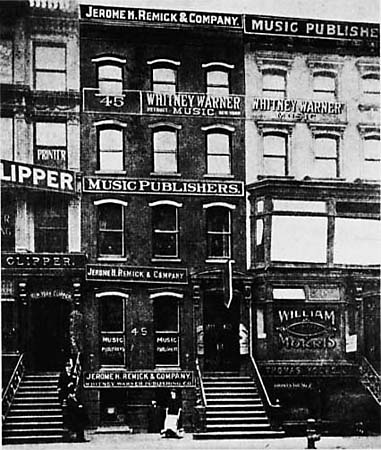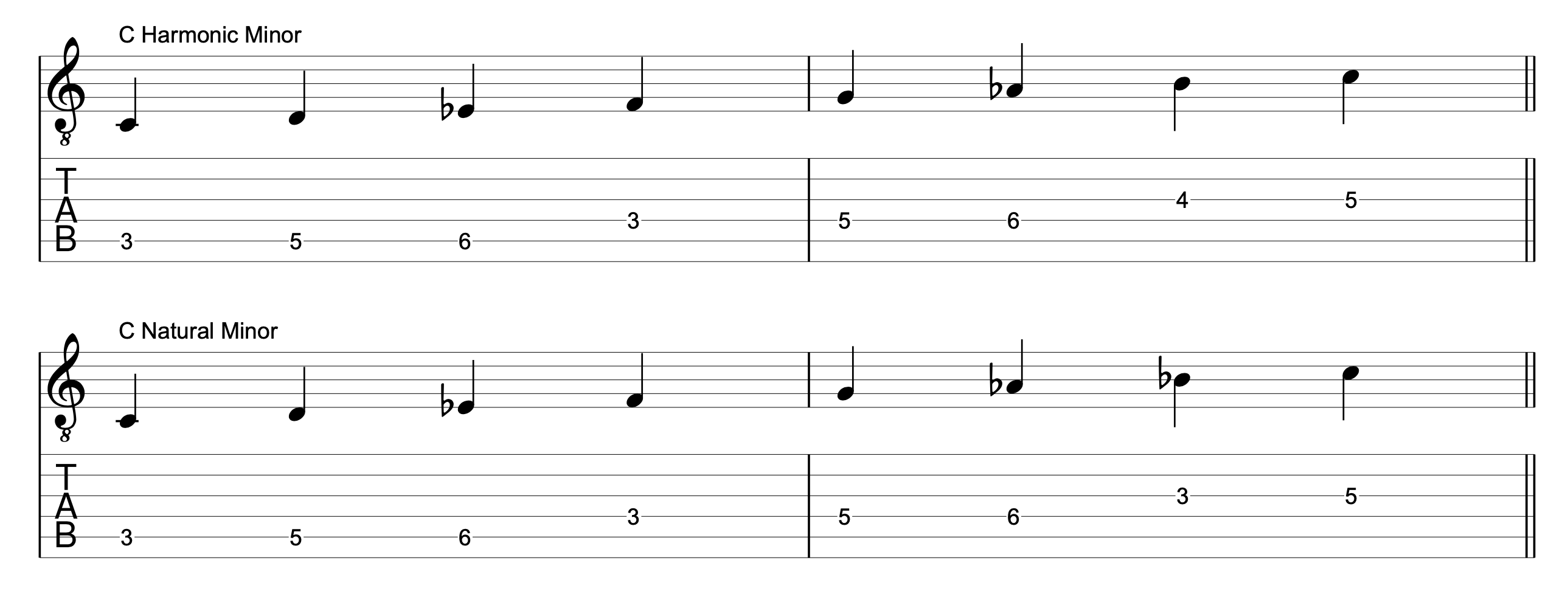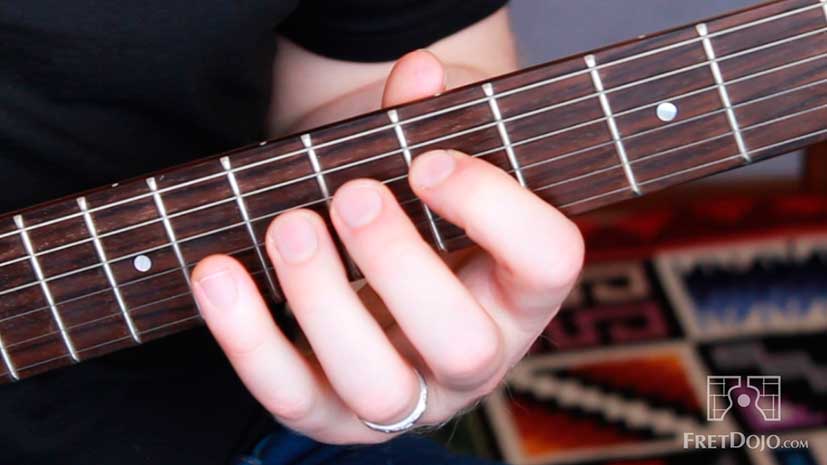Have you been struggling to make a 2 5 1 chord progression guitar friendly?
Or maybe you want to understand what a 2 5 1 jazz chord progression is – and how to play it on guitar?
In today’s jazz guitar chord lesson, we’ll cover:
- The importance of the 2 5 1 progression and the theory behind it
- 20 different ways to play a 2 5 1 progression on guitar, and
- A neat way to rapidly learn all the jazz guitar chord shapes we’re going to cover.
Bonus PDF Download: To get your free printable PDF which has the jazz chord guitar tabs and diagrams for this lesson, go here>>
Where did the 2 5 1 jazz chord progression come from – and why is it important?
The 2 5 1 chord progression is the harmonic foundation for most jazz standards.
Before jazz standards even existed, there was Tin Pan Alley. Tin Pan Alley consisted of various New York music publishers and composers that wrote staggering amounts of popular music during the late 19th century and early 20th century:

Many of the tunes that were written by Tin Pan Alley composers used the 2 5 1 progression. Jazz musicians then took these songs and incorporated that into the jazz language, bringing the two five one along with them.
What is a 2 5 1 Progression and How Can I Build One for Myself?
A 2 5 1 progression (often marked in Roman numerals as ii – V – I) refers to the chords of the scale and key the song is in.
Let’s take the good ol’ C major scale and use this as a starting point for our 2 5 1 progression:

Now, let’s build chords from the notes in the C major scale, by stacking 3rds above each scale degree:

By stacking 3rds on each scale degree, we now have all of the basic diatonic chords within the C major scale (C major, D minor, E minor, F major, G major, A minor, and B diminished).
Now let’s go further with this idea.
Let’s add an additional third on top of each degree to make 4 note chords, often referred to as jazz chords because of their jazzy sound:

Note: The above chord voicings are easy to play on piano but most of these are difficult on guitar – don’t worry, later on in this article I’ll give you plenty of great ways to play variations of these basic jazz chords.
You can refer to each chord numerically, based on the degree of the scale it is built upon. Cmaj7 would be the 1 (I) chord, Dm7 would be the 2 (ii) chord, Em7 would be the 3 (iii) chord, and so on.
This is where the meaning of ‘2 5 1’ comes from.
2 5 1 in C major would be the sequence of chords built on the 2nd, 5th, and 1st degree of a C Major scale – so Dm7 (ii), G7 (V), and Cmaj7 (i).
Read on to learn various sequences of ii V I guitar chords and you’re set to be able to play this on the fretboard.
How can I apply this to my playing?
I’m glad you asked!
You can take this simple chord progression and voice them in different ways to add some color. I’ve arranged the following 2 5 1 guitar chords in a series of ‘levels’, with the chord voicings in each level getting more and more colorful and complex as we progress.
Side Note: Voice Leading
Notice that in the following examples how common notes between chords are usually held from one chord to the next, or move only by either a half-step or whole-step in the upper voices.
This is called voice leading and is a good rule of thumb to sounding jazzier in your chord playing, rather than jumping all around the fretboard.
However, our bass note is the exception. The bass, typically, does not need to follow these guidelines and is free to move with the root of the chord if needed/desired.
Note: I have kept the rhythms very simple in the examples, but feel free to experiment with your own rhythm patterns like how I demonstrate in the video above.
2 5 1 Chord Progression Guitar Level 1 Voicings
Let’s take a look at some basic guitar 2 5 1 chord voicings that sound great.
Option 1:

This example of 2 5 1 in C Major is pretty basic – in fact, I’ve omitted the least important note, the 5th, from each of these jazz chords to make them as playable as possible.
But:
It fills in the harmony and sounds great in a solo/duo situation.
Notice how the top 2 voices of the chords voice lead nicely. There’s the common note of F between the Dmin7 and G7 (3rd fret of the D string) and B between G7 and Cmaj7 (4th fret of the G string). No note is descending more than a half step which results in that smooth sound which is so important for jazz.
Option 2:

Here’s another basic example but this time with full 4 note chord voicings.
As per the previous example, this also voice leads well. There’s at least one common note between each chord change and no voice (except the bass) is moving more than a whole step away.
Smooth voice leading is a common theme you’ll see through all the 2 5 1 jazz chord progression guitar voicings I’m covering today – it’s the key to sounding like a pro jazz player.
2 5 1 Chord Progression Guitar Level 2 Voicings
In these excerpts, we’re going to start adding more extensions while continuing to voice lead the higher parts of the chord.
Option 3:

This one sounds a bit more jazzy.
When you add the note E to both the D minor and G chord, you get much more color to the progression – this brightens up things quite a bit!
The same applies when we add the note D to the C major chord at the end.
Option 4:

This time around we’ve added the 11th (G) to D minor, the 9th (A) to G, and the 13th (A) to C major. These notes are what we call extensions – notes that add interesting color to the fundamental harmony.
For me, adding the 11th scale degree to a minor 7th chord makes it sound a bit suspended, while the G9 and Cmaj13 sound bright.
2 5 1 Chord Progression Guitar Level 3 Voicings
Let’s say you’re playing in a band situation with a drummer, bassist, and horn player.
When accompanying the other instruments, you’ll want to remove the low root notes from your 251 guitar chords. That way you’ll stay out of the bassist’s way. This also allows for more hip voicings, as one of your fingers won’t be stuck holding down the bass note, giving freedom for adding more extensions and tensions instead.
Option 5:

In Example 5, we’re continuing to use colorful chord extensions (i.e. Dmin9), but we’re also borrowing some notes from the parallel minor (C minor).
Note how I’ve borrowed the note Eb and added that to our G9 chord. This makes it a G9b13.
This chord is a bit “spicy” and creates a lot of tension. Since the tension is greater, it makes the resolution to the dreamy C6/9 that much sweeter.
Option 6:

With this sequence, we’re continuing to add colors to each of these 251 jazz chords (the note E to D minor and G7, also the D to the C major).
However, we’ve also borrowed the note Ab from the parallel minor and added that to the G chord.
The G13(b9) can sound a bit strange if you’re not used to it, but it can be a very hip sound. You have the brightness of the 13 (E) and the darkness of the b9 (Ab). Like in the previous example, this use of tension creates a stronger, more satisfying resolution when we get to the Cmaj9.
2 5 1 Chord Progression Guitar Level 4 Voicings
Option 7:

Here, we’re continuing to build off of the same shapes we’ve been using earlier.
For instance, the G7 chord in example 7 borrows the notes Eb and Bb from C minor.
I love these 2 5 1 chord progression guitar voicings because of how jazzy they sound.
Option 8:

Now we’re getting more tricky.
Here we’ve added the 9th to the D minor, creating a tense sound in the middle of the chord.
We then follow it with a G altered chord, adding the notes Ab and Db respectfully.
This G altered chord sounds dark and harsh which contrasts nicely to the bright and blissful Cmaj9 voicing that follows.
2 5 1 Chord Progression Guitar Level 5 Voicings
Option 9:

Option 10:

In both these examples, we’re continuing to use the more suspended sounding voicings for our D minor chord and brighter sounding voicings for our C major chord.
However, as you’ve probably already noticed, our G chord continues to get more and more dissonant. The G7(b13b9) is one of my favorites – it sounds dark and somber which adds an interesting twist to this timeless 2 5 1 progression.
The Minor 2 5 1 Progression
We can also play a 2 5 1 progression in a minor key.
This time, we’ll build chords primarily from the harmonic minor scale (and a little from the natural minor):

Minor 2 5 1 Chord Progression Guitar Level 1 Voicings
Let’s begin our look at the minor 2 5 1 with larger chord voicings (like we did with the major 2 5 1 progression earlier). Take a look at these examples:
Option 11:

Option 12:

As you’ll notice, the 2 chord in a minor 2 5 1 is different. We’re no longer working with a Dmin7 – it’s now a Dmin7b5 instead.
The reason:
An A natural is not found in the C harmonic or natural minor scale – that scale note is now Ab.
These voicings fill out the harmony nicely and are great in smaller playing settings. You’ll also see that each progression adheres to good voice leading, as no note in the higher voices moves more than a whole step.
Minor 2 5 1 Chord Progression Guitar Level 2 Voicings
Option 13:

In this example, we’re substituting our G7 chord with a D fully diminished 7th chord (Ddim7). This chord implies a dominant 7b9 sound on the G7.
The Ddim7 chord in this context sounds quite dark. This works well in a minor 2 5 1 progression as it not only adds tension but adds more emotion to what you’re playing.
Option 14:

Here’s an example using some 5 note voicings.
I like the G7 and Cmin9 voicings in particular because of the emotional relationship between the two chords. To me, the G7 sounds pointy and bright while the Cmin9 sounds sad and reflective.
Minor 2 5 1 Chord Progression Guitar Level 3 Voicings
Let’s take a look at some voicings that are more combo friendly.
Option 15:

Just like with some of the excerpts from the Major examples we covered earlier, we can add the 11th to our Dmin7b5 chord. This adds a bit of suspense and a ‘floaty’ sound – one of my favorite voicings and reminiscent of Ed Bickert’s sound.
Option 16:

Notice in this example how we’re playing an Fm7 chord where the Dmin7b5 is written.
When we take a look at the notes in Dmin7b5 (D – F – Ab – C), we see that the top three notes make up an F minor triad. We can, therefore, substitute our Dmin7b5 with an F minor triad and extensions of this, such as Fm7.
With all of the chords listed, major, minor, or otherwise, we can take the triads found within our extended chords and create new voicings. Pretty cool, huh?
Minor 2 5 1 Chord Progression Guitar Level 4 Voicings
Option 17:

Option 18:

Remember when we were talking about borrowing notes from the parallel minor for major 2 5 1 progressions?
You can apply that same technique when creating voicings for the minor 2 5 1 but in reverse – borrowing notes from the parallel major.
In the first example, we’re borrowing E Natural from the parallel major on our Dmin7b5 chord. We’re also borrowing A natural from C major when adding that to our G7 chord in the second example.
When you borrow these notes, you’re able to add brightness to a darker, more reflective progression. It adds a nice contrast!
Minor 2 5 1 Chord Progression Guitar Level 5 Voicings
Option 19:

Option 20:

In these examples, we’re continuing to run with our “borrowing” concept.
This time, we’re applying those borrowed notes from the C Major scale to the C minor chord in each example.
Ways to Practice the 2 5 1 Chord Progression On Guitar:
One great way to get started practicing these 2 5 1 progressions is with a metronome or a drum track.
Set your tempo to 120bpm and practice the following excerpts.
The examples have a written-out rhythm that can be applied in almost any situation. However, once you get more comfortable, you can start playing around with other rhythmic ideas. When you’ve mastered one set of voicings move on to the next set:
Example 1 (Major ii – V – I Chord Progression Guitar):

Exercise 2 (Minor ii – V – i Chord Progression):

If you’re feeling especially adventurous, practice this same etude in all twelve keys! Go around the circle of 4ths so you can familiarize yourself with the 2 5 1 chord progression in other keys apart from C.
What do you think?
Before you go – a question:
Which 2 5 1 chord progression guitar voicings from this article were your favorite – and why? Be sure to leave a comment below telling me your thoughts!
About Andrew Dodge:

Andrew Dodge is currently a session guitar player based in Portland, Oregon. He received his Bachelor’s in jazz guitar performance at Washington State University.
During his studies, Andrew gained performing, recording, composition, and teaching experience. He has performed and recorded professionally with a wide variety of bands that spanned across various genres which includes jazz bands, classical ensembles, rock bands, and Latin groups.
Andrew also had the opportunity to perform with world class musicians such as Stanley Jordan and Jeff Coffin.
He has continued to study with Steve Postel who is currently playing with renowned session musicians such as Leland Sklar, Russel Kunkel, Danny Kortchmar, and Waddy Watchel in the band, Immediate Family.
Andrew is currently producing his first studio EP which is set to release in early 2022.


This is the finest resource for ii-V-I progressions that I have ever seen in one place. Thanks for explaining a little theory behind each option . I will make it a point to add these progressions to my daily practice routine.
Wow! Really thorough and well explained! Thank you
I ask myself why some chords are called “diatonic chords” when they actually contain 3 tones and not 2, as indicated by “di.” Can someone please answer this?
In this case ‘di’ in the word ‘diatonic’ doesn’t refer to the number 2. See this article under the ‘History’ heading in Wikipedia – https://en.wikipedia.org/wiki/Diatonic_scale – diatonic refers to ‘belonging to a scale’.
A valuable compendium/review, but more than that a valuable jumping off point for exploring inexhaustible combinations. For example. take an inversion of Dm7b5 on the inner four strings, say, CFAbD then lower the
c to B to get G7b9. repeat at the next inversion of Dm7b5, DAbCF. Repeat twice more and resolve to Cm6. Or chase the Dm7b5’s up the neck, one beat each, then G7+9, BFBbD and move that shape down in minor thirds to resolve to Cm7.
Take all the 251 in Cmajor transpose them to Ebmajor then combine any one them with the 251 in C minor and you get “Autumn Leaves”, if you interpolate an Abmajor chord between the Eb major and Dm7b5. I could go on and on, but I’ll stop now.
Thank ‘s for your lesson but it is really out of reach for me.
The level is way too High as i am just starting to learn music theory.
Thank you anyway to make us share your incredible (for me)
Knowledge.
Is the backing track for this available to download please?
No I’m sorry, that’s no longer available but have a look on YouTube for ‘2-5-1 C major backing track’ or similar and you should find something!